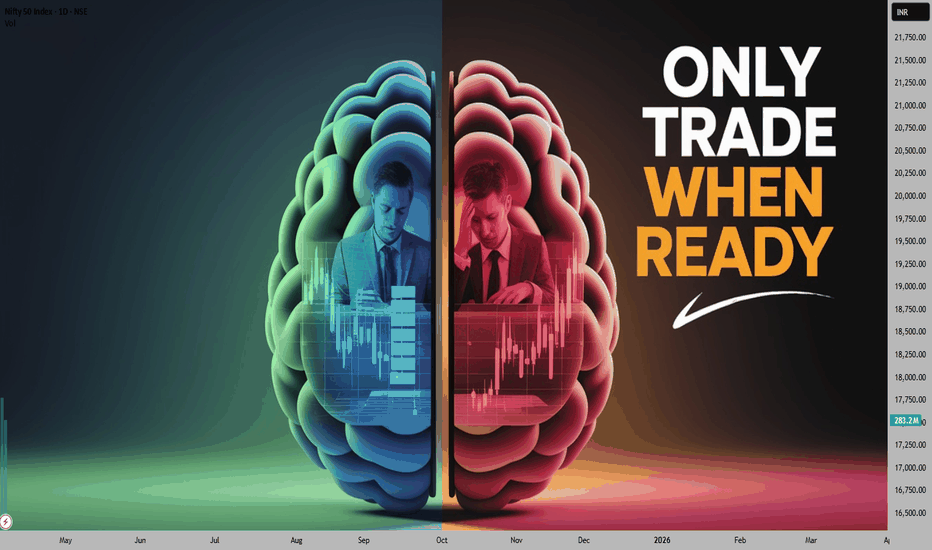Trade Only 1 Setup a Day – Here’s the One I Use!Hello Traders!
Ever heard the phrase: “Less is more” ? That applies perfectly to intraday trading. Chasing multiple setups often leads to overtrading, emotional decisions, and avoidable losses . Today, I’ll share why I prefer trading just one high-quality setup a day — and the exact one I personally use to stay consistent and stress-free.
Why Just One Setup a Day Works Wonders
Focus = Better Execution: When you wait for your setup, you don’t get distracted by noise.
Avoids Overtrading: No revenge trades, no chasing — just clean, planned execution.
Improves Risk Management: With one trade, you manage position sizing, SL, and RR with more clarity.
The Setup I Personally Use (VWAP + CPR Rejection Strategy)
Step 1 – Mark CPR + VWAP Zones
→ CPR gives range reference, VWAP shows volume-weighted fair value.
Step 2 – Wait for Rejection or Reversal from Zone
→ Look for price rejecting CPR or VWAP with a strong reversal candle (e.g., engulfing, pin bar, etc.)
Step 3 – Entry with Confirmation + SL
→ Enter only after breakout candle closes beyond the rejection level
→ SL = just above/below the zone
→ Target = 1:2 or nearest support/resistance
Why I Stick to This Setup
It Works Across Indices: Bank Nifty, Nifty, and even stocks.
Clear Risk-Reward Ratio: I know my exit before I enter.
Less Screen Time, More Peace: Once the trade is done, I’m done.
Rahul’s Tip
The market gives hundreds of signals, but only a few are clean. Trade one that fits your rulebook and let the rest go. Discipline > Drama.
Conclusion
You don’t need 10 trades a day to be profitable. You just need one trade with logic, structure, and discipline . Master one setup, build confidence, and let consistency build your capital.
What’s your favorite intraday setup? Drop it in the comments and let’s share ideas!
Disciplinedtrading
The Psychology Setup: Trade Only When These 2 Conditions Are MetHello Traders!
Most traders obsess over strategy, indicators, and chart patterns — but the real edge often lies in psychological discipline . Want to take high-probability trades and avoid emotional traps? Then here’s a simple rule: Only trade when these 2 psychological conditions are met.
Let’s explore the setup that separates impulsive traders from consistent ones.
Condition 1: You’re Emotionally Neutral
No Fear of Missing Out (FOMO):
Don’t enter just because “the market is moving.” If your emotions are rushing, it’s a trap.
No Revenge Trading:
If you’re reacting to a loss, step back. Emotional decisions lead to impulsive trades, not logical setups.
Clear Mindset:
If you’re tired, angry, or distracted — don’t trade. Your mind is your main weapon in the markets.
Condition 2: You Have a Clear Trade Plan
Setup Must Match Your Strategy:
Only enter if the setup matches your pre-defined plan. No “gut feeling” entries allowed.
Defined Entry, SL, and Target:
If you don’t know your stop loss before entering — it’s not a trade, it’s a gamble.
Risk is Calculated:
Trade size must be aligned with your capital and risk management rules — no oversized positions.
Rahul’s Tip
Most losing trades don’t fail because of strategy — they fail because of mindset. Protect your psychology and let the setup come to you. Don’t chase it.
Conclusion
Discipline is a setup. Trade only when you're mentally calm and technically aligned. These two conditions act like a filter — they save you from bad trades and help you focus only on the high-quality ones.
What’s your rule before entering a trade? Do you check your mental state first? Let’s talk below!
George Soros's Top Trading Rules: Master Risk and Reward
I hope you all are doing great in life and your trading journey as well! Today, I’ve brought an educational post on George Soros's Top Trading Rules . These timeless principles from one of the greatest traders in history will help you master risk management and improve your trading skills. Let’s dive in!
It’s not whether you’re right or wrong that matters, but how much money you make when you’re right and how much you lose when you’re wrong.
Soros focuses on managing risk and reward, emphasizing that being right doesn’t matter unless your profits outweigh your losses.
Markets are constantly in a state of uncertainty and flux, and money is made by discounting the obvious and betting on the unexpected.
He highlights the importance of thinking ahead and capitalizing on unexpected market moves.
The worse a situation becomes, the less it takes to turn it around, and the bigger the upside.
This rule underlines his contrarian approach of buying when others are fearful and selling when others are greedy.
Know when to cut your losses.
Soros is a big believer in exiting a losing trade quickly to protect your capital.
I’m only rich because I know when I’m wrong. I basically have survived by recognizing my mistakes.
This reflects the importance of self-awareness and adaptability in trading.
When you’re risking your own money, the first and foremost rule is survival.
Protecting capital is always the top priority, ensuring long-term trading success.
Recognize bubbles when you see them.
Soros’s theory of reflexivity emphasizes how markets can deviate from fundamentals due to investor sentiment, creating opportunities to profit.
A good trader thinks about probabilities, not certainties.
He advises traders to focus on risk management and the odds of success rather than seeking perfect predictions.
If investing is entertaining, if you're having fun, you're probably not making any money. Good investing is boring.
Patience and discipline are crucial in trading and investing.
Thank you for reading! Apply these timeless principles of George Soros in your trading journey and focus on mastering risk and reward. Share your thoughts or favorite trading rules in the comments below! Don’t forget to follow for more insightful posts. Happy Trading!


